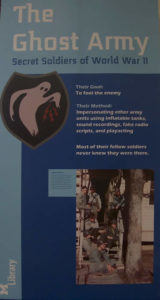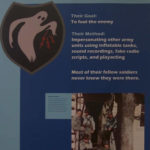June & July we celebrated the recently unclassified
story of The Ghost Army
In June 1944, a secret U.S. Army unit, 23rd Headquarters, to become known as The Ghost Army went into action in Normandy. The weapons they deployed were decidedly unusual: hundreds of inflatable tanks and a
one-of-a-kind collection of sound effects records.
Their mission was to use bluff, deception and trickery to save lives. It was a unit made up of about 1,100 men, most of which were artists and performers. They were not allowed to keep written journals, so many sketched and painted pictures to record their journey across Europe. The story of what these men accomplished was hushed by the Pentagon for more than forty years. They completed 21 missions form Normandy to the Rhine, with only 3 deaths and 13 injured.
In June 2013, we brought to life the story of these amazing men, with the help of Rick Beyer, the University of Michigan and Plate of Peas Productions, and the generous donation from Henry & Delores Kowalski; The Ghost Army traveling exhibit went on display in the Learning Center. Ten days prior to the opening of the exhibit PBS aired the debut of The Ghost Army documentary.
Special Effects
Ghost Army soldiers went to great lengths to carry out their deceptions. They altered their uniforms, putting on the patches of the units they were impersonating, then going into nearby towns to spin their counterfeit stories for whatever spies lurked in the shadows. They referred to this as “special effects.â€
These are patches of some of the units they impersonated, and a standard issue Army sewing kit. “My shirts were all wrecked from having sewn so many different shoulder patches on them,†recalled Ghost Army veteran Jack Masey.
Radio Deception
Ghost Army radio operators set up phony networks to fool German intelligence officers listening in. Operators were trained to copy the “fistâ€â€”the telegraph style—of operators in real units they were impersonating. That way German intelligence wouldn’t get suspicious. Radio deception was carefully diagrammed and scripted down to the smallest detail, as shown by these documents reproduced from actual Ghost Army missions.
Wire Recordings
The wire recorder is all but forgotten today, but it was state of the art technology during World War II. A predecessor to the tape recorder, it recorded sound onto magnetized wires about the thickness of a fishing line. When a wire broke, it could be repaired by heating up the ends with a cigarette and melting them together. The fidelity of the wire recorders was surprisingly good.
Ghost Army Reception
On June 21, 2013 The Highground was the host site for Ghost Army Veteran Mike Demerath (and Family), Donald Fox (son of GA Veteran Fredric Fox) and Lisa Kennedy-McGinley (and family), (daughter of GA Veteran John Kennedy). We were honored to have these families along with several community members, staff and board members, share in an evening of reminiscing, education, healing and friendship.
Mike Demerath was a sound engineer and was a master at deceiving the enemy with fake radio transmissions and phony sounds of machinery and men moving about. Fredric Fox was the unit’s official historian and the man that made “impersonating an officer†part of their daily routine. In his infamous words, “you can’t portray a woman if bosoms are forbiddenâ€. John Kennedy was a member of the 603rd, camouflage was his specialty. Turning an air field complete with hanger, planes and vehicles into what looked like nothing more than a farm house and fields.


